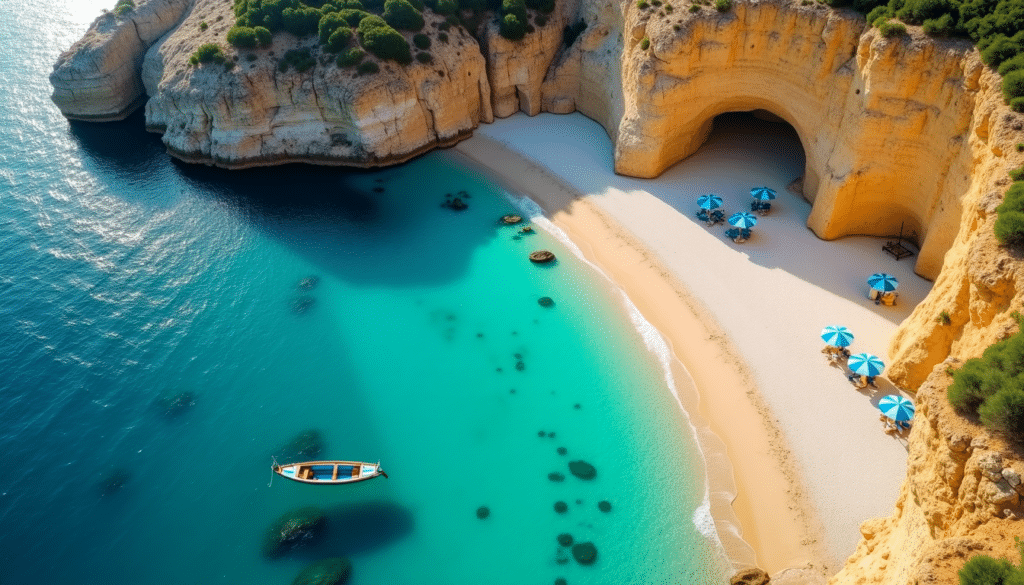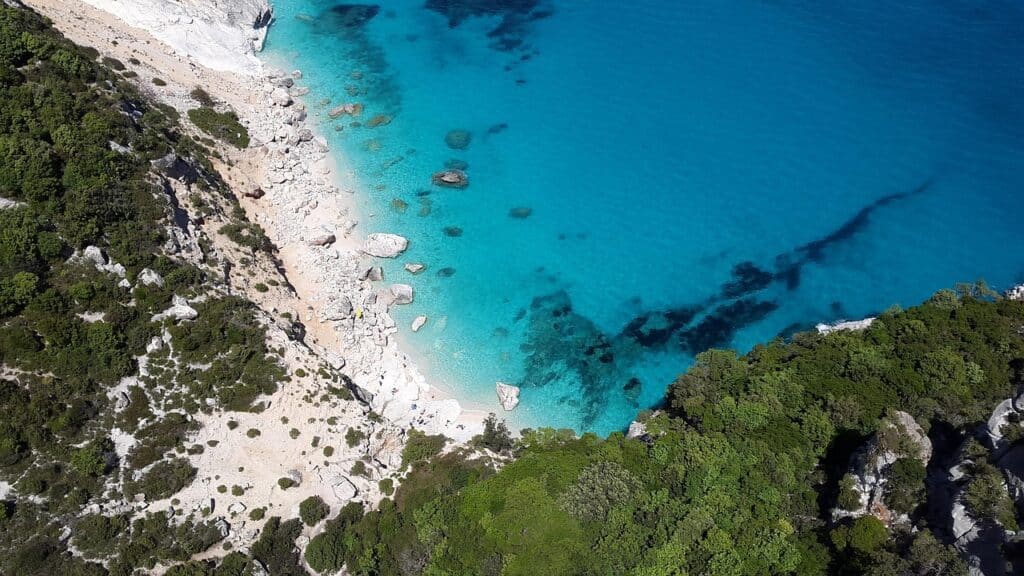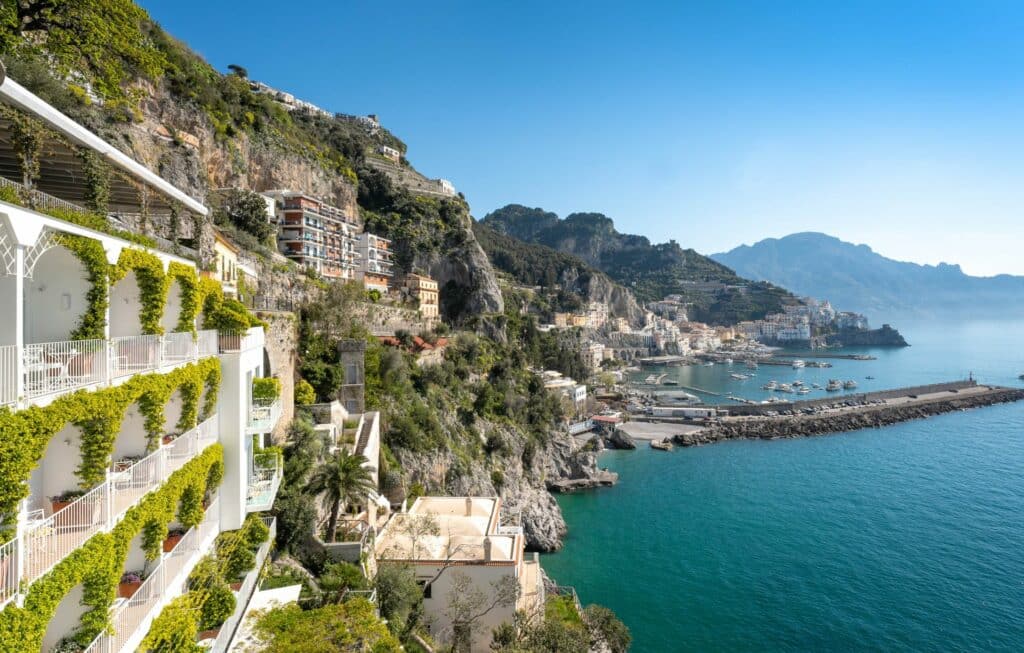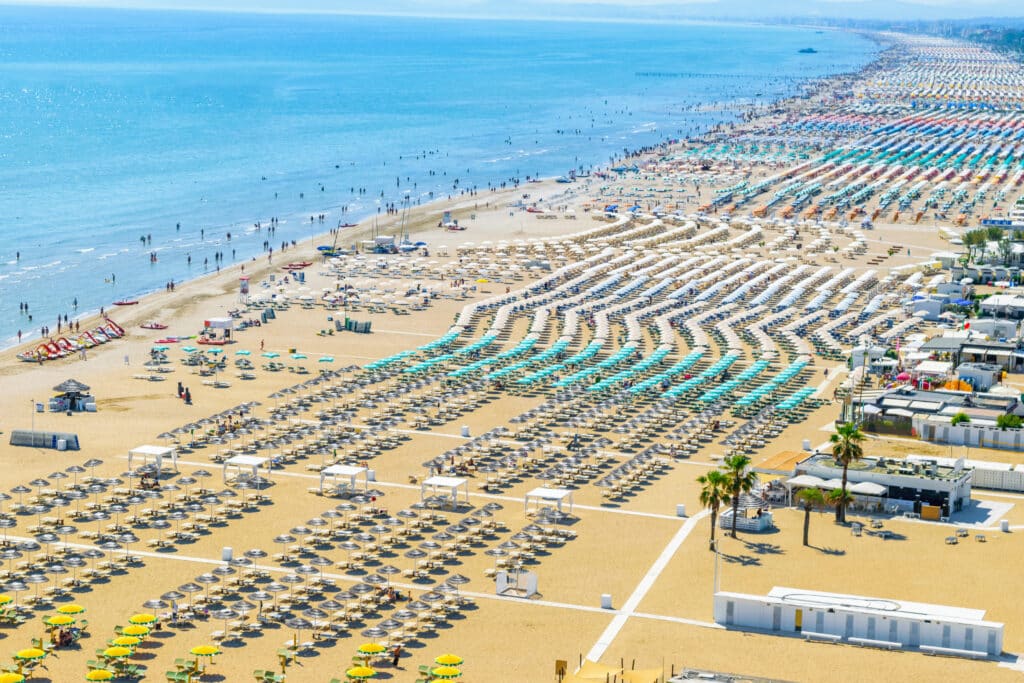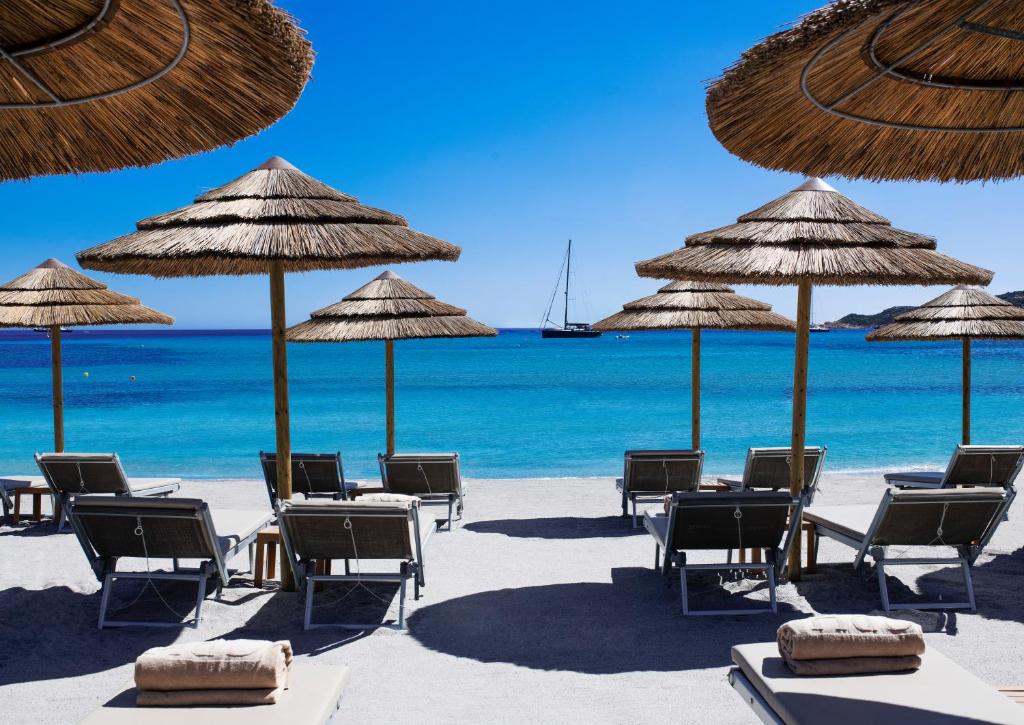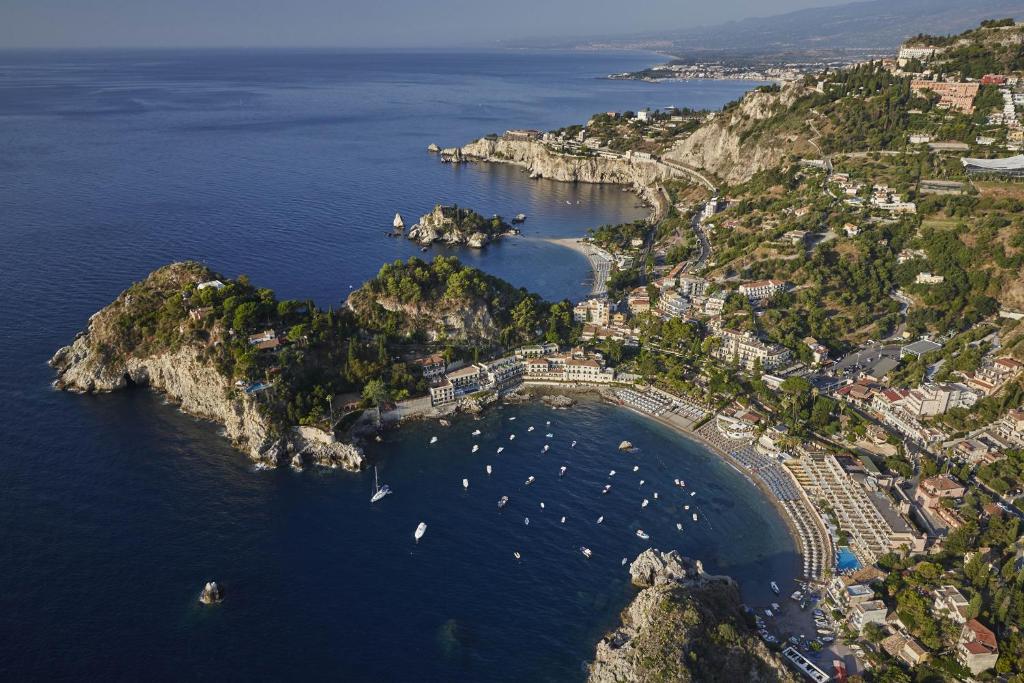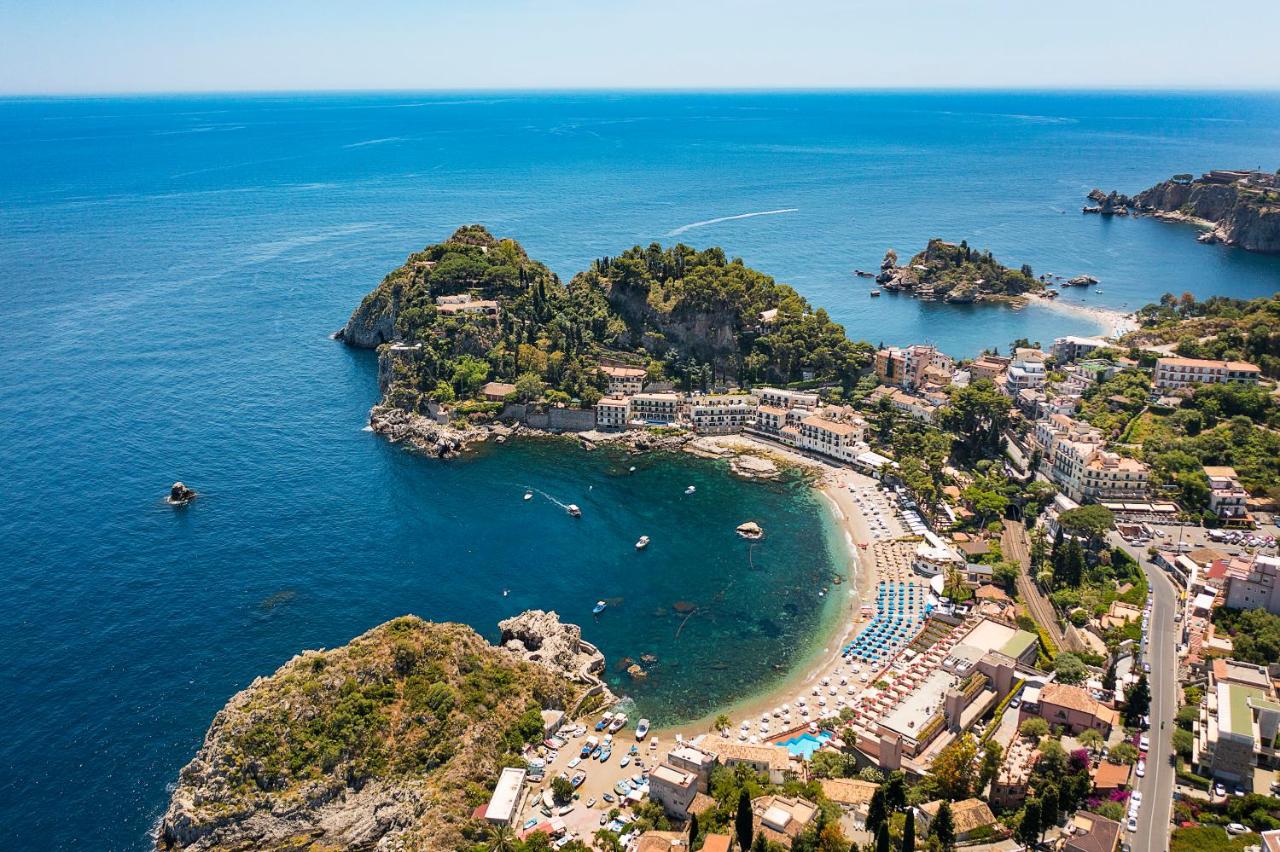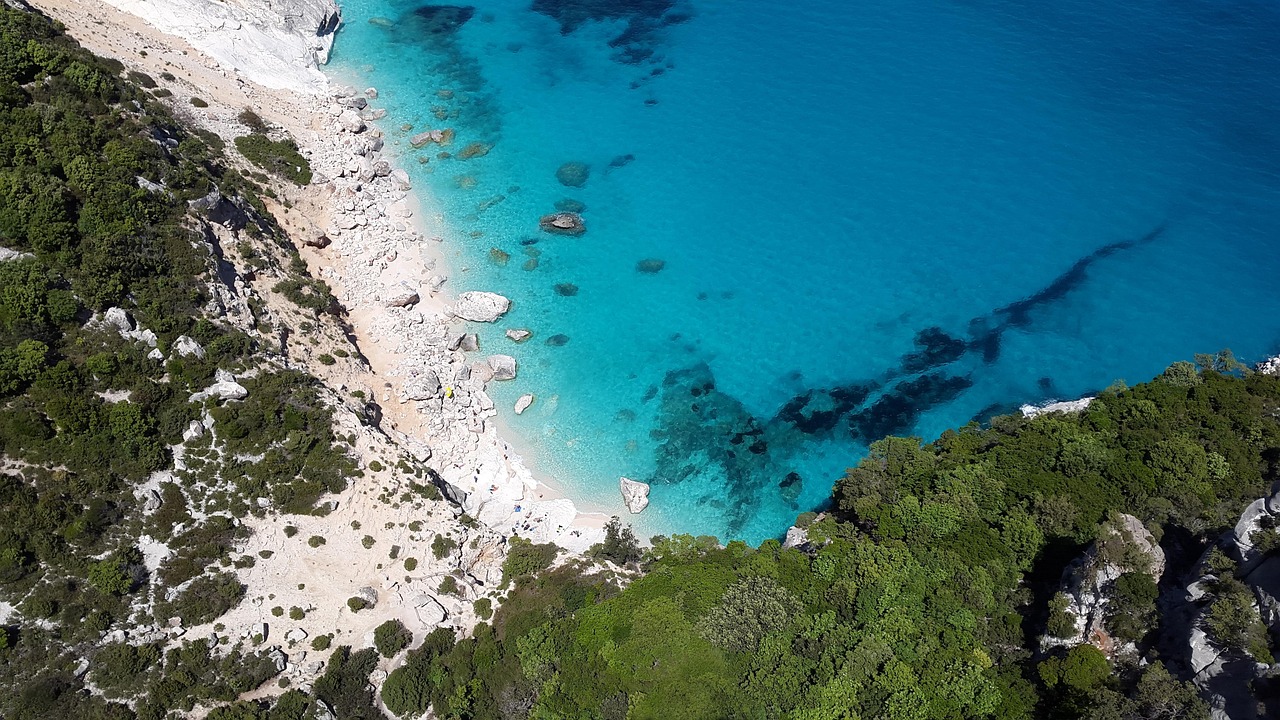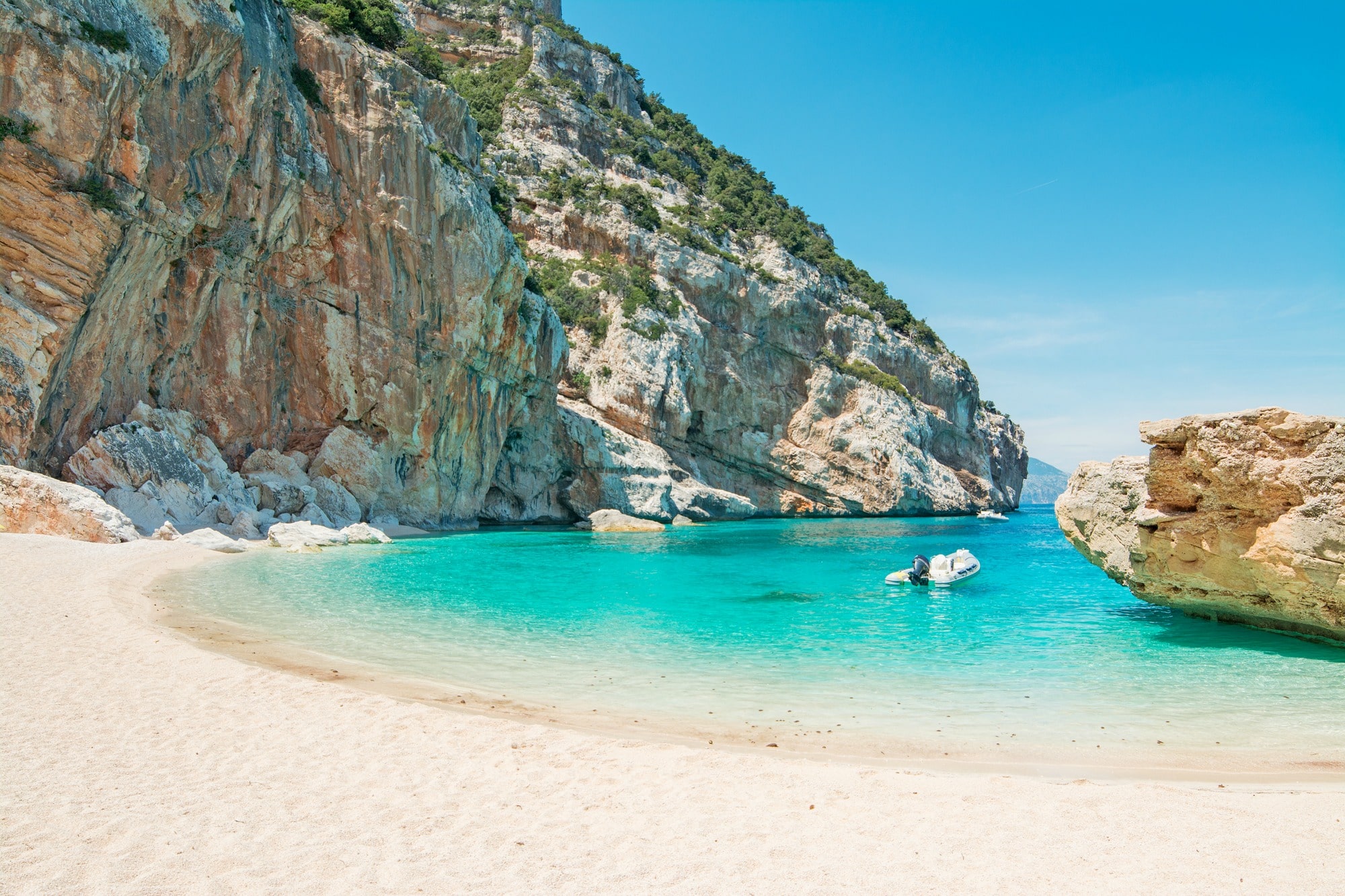Sardinia‘s breathtaking 1,849-kilometer coastline has some of the Mediterranean’s best beaches that rival spots in the Seychelles and Caribbean.
Our beach-hopping adventures in this Italian paradise took us from the crystal-clear waters of La Pelosa to the unique quartz-sand shores of Is Aruttas. Sardinia’s beaches stand out because of their amazing variety. You can choose between family-friendly spots with gentle slopes and hidden coves like Cala Goloritze that allows only 250 visitors each day.
These beautiful beaches in Italy give you more than pristine shorelines. Some beaches showcase dramatic granite cliffs and emerald waters, while others have shallow, turquoise lagoons that families love. This piece will help you pick your perfect beach spot, whether you want thrilling water sports or peaceful moments in secluded coves.
La Pelosa Beach
La Pelosa Beach fascinates visitors with its Caribbean-like atmosphere and pristine beauty from its northwestern tip of Sardinia.
La Pelosa Beach Location
This enchanting beach lies just 2 kilometers from the harbor village of Stintino in Capo Falcone. The beach stretches 300 meters in length and reaches up to 60 meters in width. Spectacular views of Isola Piana await visitors 600 meters offshore, with the larger Isola Asinara behind it. The beach’s historical charm comes from a sixteenth-century watchtower, Torre della Pelosa, which stands guard over the landscape.
La Pelosa Beach Features
The beach boasts impressive white sand and waters that change through mesmerizing shades of azure to turquoise. The beach’s natural barrier creates a protective shield through the stacks of Capo Falcone, Piana Island, and Asinara rocks, keeping the waters safe from strong tides and northwest winds. Families with small children love these consistently calm conditions and shallow seabed.
La Pelosa Beach Access Tips
Strict access regulations help preserve this natural wonder. Visitors must secure advance reservations through the official website from June to September. The daily limit stays capped at 1,500 people, divided as:
- 700 spots bookable without time restriction
- 700 spots available within 48 hours
- 100 spots reserved for local accommodation guests
Each person pays €3.50 for entrance, while children under 12 enter free. Beach rules require straw mats under towels, ban sand removal, and restrict smoking to designated areas.
Best Time to Visit La Pelosa
Early morning hours provide the best experience at the beach. Crowds fill the beach throughout the day and stay until late evening. June or September-October offer a more relaxed atmosphere with fewer visitors. July and August bring peak crowds, making advance booking necessary.
Visitors will find complete amenities, including kiosks that serve quick meals, snacks, and refreshments. Water sports equipment rentals include windsurfing, kayaking, and stand-up paddleboarding options. Parking costs €2 per hour, with a daily maximum of €20.
Cala Mariolu
Cala Mariolu ranks as one of Europe’s most celebrated beaches and has earned recognition as the continent’s most beautiful coastal destination.
Cala Mariolu Location
This pristine cove sits along Sardinia’s central-eastern coastline in Baunei territory. The beach features a stunning mix of pink and white pebbles. Towering limestone cliffs reach heights of 500 meters and create a natural amphitheater that protects the cove from strong winds and currents.
Cala Mariolu Highlights
The beach stands out with its unique composition of tiny white pebbles mixed with pink shells. Locals call these pebbles “pùligi de nie” (snow fleas). The name “Mariolu” has an interesting story – it comes from Mediterranean monk seals that used to live in the area. Local fishermen nicknamed them “mariolo” (thief) because they would steal catches from fishing nets.
Crystal-clear waters shift from deep sapphire to bright aquamarine, creating perfect conditions for swimming and snorkeling. The beach maintains its pristine state by limiting visitors to 700 people at any time.
Dolphins frequently appear offshore, and the surrounding cliffs provide homes to several bird species:
- Peregrine falcons
- Eleonora’s falcons
- European shags
- Golden eagles
How to Get to Cala Mariolu
Visitors can reach this hidden paradise through two routes:
By Sea: Boats leave daily from three main ports:
- Cala Gonone (closest access point)
- Arbatax
- Santa Maria Navarrese
Ticket prices range from €45 to €55 per person depending on the season. Private rubber dinghies offer more flexibility, with full-day rentals (8:00 AM to 5:30 PM) costing between €100 and €250, not including fuel.
By Land: A challenging hiking trail stretches 6 kilometers from Località Piredda in the Golgo Plateau. The trek includes:
- 100 meters uphill ascent
- 560 meters downhill descent
- A three-hour one-way journey
The beach offers its most peaceful moments before 8:30 AM. Since the beach has no facilities, visitors need to bring water, food, and sun protection.
Spiaggia La Cinta
Image Source: Sardegna Turismo
La Cinta Beach stretches across San Teodoro’s northeastern coast. This spectacular 5-kilometer arc of white sand meets azure waters and ancient juniper-covered dunes.
La Cinta Beach Features
The beach’s brilliantly white sand creates a natural masterpiece as it slopes into crystal-clear waters. A unique ecosystem separates a big lagoon from the sea. Visitors can enjoy stunning views of Isola Tavolara that rises from the waters. The beach measures an impressive 3,230 meters in length with an average width of 30 meters.
The sandy seabed extends gradually into the sea. These safe swimming conditions make it perfect for families with children. The shoreline’s natural beauty remains intact despite its popularity. Fragrant juniper trees, sea lilies, and strawflowers dot the landscape.
La Cinta Beach Activities
Visitors can enjoy many activities at this well-equipped beach:
- Water sports in the designated Kite Zone
- Canoe and paddleboat rentals
- Sailing lessons
- Guided fishing excursions
- Bird watching opportunities at the adjacent lagoon
The San Teodoro lagoon lets nature lovers spot diverse wildlife. Pink flamingos, red herons, coots, and mallard ducks thrive in their natural habitat. The long shoreline makes a perfect spot for morning jogs or sunset walks.
Best Time to Visit La Cinta
La Cinta’s most peaceful moments happen in the early morning. The beach can hold up to 12,113 people comfortably. It gets busy between mid-June and mid-September.
Peak season brings essential facilities:
- Tourist information point
- Beach equipment rentals
- Freshwater showers
- Restroom facilities
- Designated waste collection areas
Getting to La Cinta is easy. You can walk from San Teodoro’s northern outskirts. Drivers will find a spacious parking area that costs €5 per day. The beach’s specially designed ramps ensure access for visitors with disabilities.
Cala Goloritze
Image Source: Strictly Sardinia
A dramatic landslide in 1962 created Cala Goloritze, which now stands as a protected natural monument on Sardinia’s eastern coast. This stunning beach sits 9 kilometers north of Baunei and shows off nature’s amazing work through its unique limestone formations.
Cala Goloritze Hiking Trail
Your trip to this hidden paradise starts at Su Porteddu in the Golgo Plateau along a clear 3.5-kilometer trail. The path rises to 470 meters above sea level and winds through ancient holm oak forests and Mediterranean scrub. Most hikers take about 1 hour and 15 minutes to reach the beach. The return climb is more demanding and takes around 1.5 hours.
Cala Goloritze Natural Features
Geological wonders make this beach truly special. A massive 148-meter limestone needle called Monte Caroddi or Aguglia stands tall at the southern end. Tiny white pebbles cover the shore instead of sand, creating beautiful contrast with the crystal-clear waters.
Limestone cliffs reach heights of 500 meters and frame a pristine cove. Fresh spring water meets the sea here, creating surprisingly cold spots in the water. The water is so clear you can see up to 15 meters deep, making it perfect for snorkeling.
Essential Tips for Visiting
You need to plan ahead to visit this protected beach:
- Daily visitor limit: 250 people
- Entrance fee: €7 per person
- Reservation required through “Heart of Sardinia” app
- Beach hours: You must leave by 4 PM
Bring these essential items:
- Minimum 2 liters of water per person
- Proper hiking shoes with good grip
- Sun protection gear
- Snorkeling equipment
- Food supplies (no facilities available)
Boats must stay 200 meters from shore to protect the beach’s natural state. Note that overnight camping is not allowed, which helps keep this natural monument pristine since its declaration in 1993.
Porto Giunco Beach
Image Source: Sardegna Turismo
Porto Giunco stands as a tropical paradise in the Mediterranean’s heart. This protected marine area of Capo Carbonara features pristine white sand that meets crystal-clear waters.
Porto Giunco Location
You’ll find Porto Giunco in the village of Villasimius on Sardinia’s southeastern coast, about 52 kilometers from Cagliari. The beach spans 600 meters along the coastline. Its position between two bodies of water has earned it the nickname ‘beach of the two seas’.
Beach Facilities
The beach provides complete amenities throughout the season. A wooden pathway connects the parking area to the shore and helps people with limited mobility access the beach. The beach comes equipped with:
- Stabilimento Balneare Porto Giunco where you can rent sunbeds and get refreshments
- Chiosco di Notteri that serves sandwiches, pizza, and beverages
- Public toilets at 50 cents per use
The parking lot fits up to 800 vehicles, and rates change with seasons. Summer parking costs €5 per day as of 2024.
Best Photo Spots
Porto Giunco’s iconic Spanish watchtower serves as the centerpiece of many beautiful photo opportunities. The Torre di Porto Giunco, a 17th-century structure, rises 9 meters high and watches over the bay. A quick 15-minute walk from the parking lot takes you to this historic tower, where you can capture stunning views of:
- The vast white sand beach below
- Stagno di Notteri, a peaceful lagoon where pink flamingos gather
- The surrounding Mediterranean plant life
- Crystal-clear waters that shift from turquoise to deep blue
Protective headlands cradle the beach and create an almost magical atmosphere. The beach takes on a new character at sunset when torches light up the shoreline, setting the perfect scene for memorable photos.
Nature lovers will find spectacular underwater views with granite pinnacles decorated by yellow sea daisies and red soft coral. The ancient juniper trees, Mediterranean scrub, and eucalyptus grove’s path give photographers great shots year-round.
Cala Luna
Image Source: Cestee.com
Cala Luna, a crescent-shaped paradise, lies between the territories of Baunei and Dorgali. This stunning beach features golden sands that meet crystal-clear waters at the mouth of Codula di Luna torrent.
Cala Luna Cave System
The beach’s standout feature includes five spacious natural caves along the shoreline that provide natural shelter from summer heat. A remarkable karst system creates an underwater cave network that spans over 80 kilometers inland. The Bue Marino Cave’s three branches are worth exploring – north and south branches are available by foot, while the central arm remains reserved for underwater exploration. Ancient petroglyphs from the pre-Nuragic period adorn the cave walls, showing the ‘Dance of the Sun’ and fertility rituals.
Beach Activities
An 800-meter stretch of fine golden sand presents many recreational possibilities. Water lovers can enjoy:
- Snorkeling through underwater caves and canyons
- Rock climbing on vertical cliffs, first pioneered by climber Manolo
- Kayaking along the pristine coastline
- Swimming in waters that shift from cobalt blue near caves to greenish hues elsewhere
Access Options
Cala Luna is available through two main routes:
By Sea: Regular boat services run from:
- Cala Gonone (20-minute experience)
- Santa Maria Navarrese
- Arbatax
By Land: A challenging hiking trail begins at Cala Fuili, covering approximately 12 kilometers round trip that takes 6 hours to complete. The path weaves through Mediterranean vegetation, and hikers must navigate large rocks in certain sections.
Local Tips
A bar/restaurant sits nestled within the Mediterranean maquis, which was once a coal shop until its transformation in the 1980s. The best time to visit is during June, July, or September when temperatures stay pleasant and tourist numbers remain moderate. The most serene moments happen in early morning hours, especially after tour boats leave. Note that you should bring enough water and refreshments since beach facilities charge premium prices.
Cala Brandinchi
Image Source: Tripadvisor
People call it “Little Tahiti” because of its exotic charm. Cala Brandinchi captivates visitors with its pristine shoreline in the protected marine area of Capo Coda Cavallo.
Beach Characteristics
The 750-meter stretch of coastline features beautiful white sand surrounded by sweet-smelling Mediterranean plants. The beach gives you a breathtaking view that stretches from Tavolara island’s distinctive shape in the north to Isola Ruja in the east, and reaches Capicciolu Point in the south.
Sand dunes sit behind the shore, decorated with sea lilies, junipers, and rushes that form a natural wall. A lush pine forest and the Brandinchi Pond make the scenery even more beautiful. Bird lovers can spot herons, flamingos, and the rare cavalieri d’Italia here.
Family-Friendly Features
The seabed has a gentle slope and stays shallow for tens of meters, which creates a natural pool that families love. Kids can swim safely in the crystal-clear waters that stay calm most of the time. The beach’s width ranges from 20-25 meters at different spots, so beach visitors have plenty of room to relax.
Facilities
The beach club gives you complete amenities all season long:
- Large burgundy umbrellas and adjustable deck chairs
- Restrooms and shower facilities
- A well-stocked chiringuito that serves drinks and snacks
- Boat excursion services to explore:
- Tavolara Marine Protected Area
- Maddalena Archipelago
- Gulf of Orosei
The club opens daily from 9:00 AM to 6:30 PM. Cars and motorcycles can use the private parking area, but RVs cannot. Parking fees change with the season, from €1.50 in low season to €2.50 during peak months.
The best time to visit is between October and May. You’ll find both equipped and free areas on the beach. Summer visitors should book umbrellas ahead of time since facilities fill up quickly each morning.
Is Arutas Beach
Image Source: discover-sardinia.com
The province of Cabras in Sardinia’s western coast features Is Arutas Beach, which stretches for 2 kilometers and showcases nature’s artistry. This shoreline differs from typical Mediterranean beaches because of its unique composition and wild character.
Unique Quartz Sand
The beach’s extraordinary sand composition earned it the nickname “beach of the grains of rice”. Natural erosion has shaped millions of tiny quartz granules that create a mix of white, pink, and green hues. The Sinis Peninsula’s granite rocks underwent chemical progress and atmospheric processing to form these small, smooth grains. Sunlight makes these quartz particles sparkle like diamonds scattered across the shore.
Swimming Conditions
Is Arutas Beach welcomes swimmers from June through October, with water temperatures staying above 20°C. The beach conditions vary throughout the year:
- August sees peak water temperatures of 25.2°C
- February brings the lowest temperatures at 13.7°C
- Spring temperatures average 15.9°C
A quick-dropping seabed creates perfect conditions for snorkeling enthusiasts. Notwithstanding that, strong winds sometimes hit the beach, making it popular among surfers even in winter.
Local Amenities
The beach offers basic facilities while keeping its natural character. Visitors will find:
- Parking spaces (€10 daily fee)
- Public toilets and showers
- Wi-Fi connection
- Local restaurants and cafés
Visitors should arrive before 9:00 AM to best enjoy the beach. The beach’s western location makes it perfect for sunset watching as golden light bathes the unique quartz landscape. Travelers can explore the Tharros archeological site and San Salvatore’s historic village on their trip to Is Arutas.
Tuerredda Beach
Image Source: Strictly Sardinia
Tuerredda Beach stretches across a pristine double-arched paradise spanning 500 meters along Sardinia’s southwestern coastline between Capo Malfatano and Capo Spartivento.
Beach Features
Fine white sand decorates the shoreline and creates a stunning contrast with crystal-clear waters. The water’s color transitions from emerald green near the shore to deep blue further out. Isola Tuaredda, a small island about 150 meters from shore, beckons swimmers to explore its shores. The beach’s backdrop features untouched Mediterranean vegetation that surrounds Sa Tuerredda nuraghe’s ancient remains.
Natural barriers shield the beach from mistral winds. This protection creates calm waters that families love. The seabed slopes gently into the sea and provides safe swimming conditions. Snorkeling enthusiasts will find rich marine life in these waters.
Water Sports
Two fully equipped bathhouses at Tuerredda provide several water activities:
- Canoe rentals
- Pedal boat excursions
- Small zodiac rentals
- Snorkeling equipment
Nearby Attractions
The area boasts several fascinating spots. A 17th-century Aragonese watchtower stands atop Capo Malfatano with spectacular coastal views. Visitors can explore:
- Porto Tramatzu beach
- Cala Zafferano’s pink sands
- Is Arenas Biancas dunes in Porto Pino
Beach authorities enforce strict environmental protection rules. Since summer 2020, the beach allows a daily maximum of 1,100 visitors. This includes 729 spots in the free beach area and 371 in beach establishments. The beach operates as a plastic-free and smoke-free zone from June through September. Smoking is allowed only in designated areas.
Tueredda Beach Club and Tropico Mediterraneo offer excellent beach services with umbrellas, sunbeds, and refreshment spots. Tueredda Beach Club’s Poseidon restaurant serves full meals, while Tropico Mediterraneo runs a convenient beachside kiosk.
Spiaggia Capriccioli
Image Source: ️Sardinian Beaches
Capriccioli Beach captivates visitors with its twin coves of fine white sand and crystal-clear turquoise waters along Costa Smeralda’s pristine shores.
Location Details
This beautiful beach sits 15 kilometers south of Porto Cervo in Sassari Province. A small peninsula covered in thick Mediterranean vegetation surrounds Capriccioli. The beach features two main coves, with the northern stretch being longer and more popular with beachgoers. Native flora like pine trees and juniper creates a natural windbreak that provides welcome shade during sunny afternoons.
Beach Facilities
Natural beauty meets visitor comfort at this stunning beach. A lifeguard watches over swimmers throughout the season, and the beach offers these amenities:
- A beachside café with sandwiches, salads, and quick meals at good prices
- Umbrella and lounger rentals (book ahead)
- A handy pier that zodiac boats can use
- Well-kept restrooms
Best Times to Visit
The beach experience changes with seasons:
Spring (March to May) and autumn (September to November) bring pleasant temperatures between 19°C and 28°C. Families with children love the shallow, clear waters that are perfect to see the rich marine life while snorkeling.
Summer months (June to August) heat up to around 31°C and draw bigger crowds. You’ll get the best experience by arriving early before the beach gets busy. Winter months (December to February) cool down to 14°C-16°C, and the beach becomes peaceful with fewer visitors.
The beach has several parking options. Two barrier-controlled lots near the beach fill up quickly, with extra spots along the approach road. Parking costs €20 per day, which reflects this Costa Smeralda beach’s popularity.
Cala Coticcio
Image Source: Strictly Sardinia
Cala Coticcio sits nestled on Caprera Island in the Maddalena Archipelago. Its emerald-blue waters and pink granite formations draw adventure seekers from far and wide. The locals lovingly call this secluded paradise “Tahiti” – proof of Sardinia’s wild coastal beauty.
Hidden Paradise Features
The intimate cove shows off two distinct beaches. The smaller, more secluded beach gives you the most iconic views. Pink granite rocks create a stunning contrast against fine white sand. The Mediterranean scrub adds to this mesmerizing palette. Natural rock formations shield the crystal-clear waters from strong winds, keeping them calm.
Access Information
You need careful planning to reach this protected gem. The beach allows only 60 visitors each day to keep its environment pristine. Every visitor must:
- Pay a €3 environmental contribution to the National Park
- Book an authorized environmental hiking guide
- Take on a moderately challenging 3.2-kilometer trail
The hike takes about 58 minutes. You’ll walk through granite formations that wind has sculpted into fascinating shapes. The trail has steep sections that need careful footing, but the unique coastal views make it worth every step.
Photography Tips
The right timing is vital to capture Cala Coticcio’s ethereal beauty. The colors look most vibrant during peak hours, usually around 3:00 PM. Caprera’s highest point, Mount Teialone, gives you spectacular spots to photograph the cove. Local guides can point you to the large boulder overlooking the beach – the perfect spot to snap those iconic social media shots.
The beach only allows straw mats on its delicate sand – no beach towels here – to protect the ecosystem. Juniper trees scattered around the bay provide natural shade spots in summer. So pack plenty of water, snacks, and proper hiking shoes since you won’t find any facilities on-site.
Poetto Beach
Image Source: Tripadvisor
Poetto Beach stretches for 8 kilometers along Cagliari’s coastline. This stunning white sand beach ranks among Europe’s largest urban beaches.
Urban Beach Features
The beautiful shoreline runs from Cagliari to Quartu Sant’Elena. Visitors will find wide sandy spaces and crystal-clear waters here. The beach’s sandy bottom stays shallow for tens of meters, making it perfect for swimming all season long. A modern waterfront path lets people jog in the morning and take relaxing walks in the evening.
Activities and Facilities
The beach offers amazing amenities that cater to everyone’s interests. Surfers and kitesurfers come here for world-class events. Visitors can enjoy:
- Beach tennis and volleyball courts
- Diving centers and sailing schools
- Boat rental services
- Canoe excursions
Lido and D’Aquila bathhouses welcome guests without yearly memberships. Several spots like Emerson, Golfo degli Angeli, Altamarea, and Marlin rent umbrellas and chairs to beachgoers.
Local Culture
Poetto buzzes with local life year-round. Summer turns the beach into a social hotspot where swimming spots, kiosks, and evening clubs host various events. The Molentargius-Saline park sits next to the beach and lets visitors experience:
- Guided bike and walking tours
- Boat trips through old salt marsh canals
- Electric bus excursions
Dog owners can bring their pets to Settima Fermata’s dedicated area that comes with drinking fountains. Getting to the beach is easy with PF and PQ busses running from Piazza Matteotti. The Poetto Express Bus runs on summer weekends and connects the city center to Ospedale Marino with stops along the way.
Spiaggia di Maria Pia
Image Source: ️Sardinian Beaches
Spiaggia di Maria Pia sits just a kilometer from Alghero’s bustling center. This coastal gem features fine white sand that meets crystal-clear Mediterranean waters.
Beach Characteristics
The beach runs for two impressive kilometers. Visitors can choose between free areas or spots with beach equipment. Beautiful towering dunes filled with plant life create a natural backdrop. A pine forest sits behind the beach and gives welcome shade during the hottest summer hours.
The beach’s unique ecosystem features juniper trees and beautiful sea lilies that bloom when spring arrives. Wooden walkways protect the rich Mediterranean plant life and make it easy to walk across the dunes. The water stays shallow consistently, which makes swimming safe and enjoyable.
Family Activities
Families love Maria Pia because it has so many amenities and things to do. The gentle slope into the sea makes swimming safe, and professional lifeguards watch over the beach all season. Kids never get bored here thanks to:
- Fun beach activities
- Protected swimming areas
- Lots of space for beach games
- Snack bars serving quick bites
Practical Information
Getting to Maria Pia is easy. You can reach the beach:
- By walking or cycling from Alghero or Fertilia
- Taking regular busses on the Alghero-Fertilia route
- Driving there with plenty of parking spots (some paid)
The beach has complete facilities similar to Alghero’s city beaches. You’ll find places to rent sunbeds and umbrellas, plus spots to grab food and drinks. The beach gets busy by 10 AM, so it’s best to arrive early.
You’ll find the beach at Viale I Maggio 15. The location works great for day trips. Walking from Alghero’s harbor takes about 45 minutes along a scenic route, or you can take a taxi for €15.
Costa Rei
Image Source: ️Sardinian Beaches
Costa Rei’s southeastern shoreline reveals a 12-kilometer stretch of golden sand that creates an unmatched coastal paradise.
Beach Features
The clean shoreline has varying depths with shallow spots ideal for families and deeper areas for swimming enthusiasts. The main beach blends with several charming coves that each have their own character. Santa Giusta Beach features the megalithic Peppino’s Rock and a protected cove that shields visitors on windy days.
Monte Turno, south of Sant’Elmo resort, fascinates visitors with crystal-clear waters and unique rock formations. Cala Sinzias attracts beachgoers with its turquoise-blue waters and deeper swimming areas than the main beach. Families looking for peace will find Cala Pira’s clear, shallow waters perfect, with lifeguards watching over the area.
Water Activities
The coastline becomes a water sports paradise during peak season. Beach clubs along the shore rent equipment for:
- Kayaking and stand-up paddleboarding
- Kitesurfing and windsurfing in designated zones
- Diving expeditions to Scoglio di Sant’Elmo
Local Amenities
Beach clubs and kiosks line the shore to serve refreshments, meals, and drinks. Visitors can choose from many accommodation options, from the dog-friendly Tiliguerta Camping Village to all-inclusive resorts like Free Beach that offers:
- Direct beach access
- Two large pools
- Private beach sections
A weekly market runs from May through September and sells Sardinian specialties, organic produce, and local handicrafts. Restaurants in Costa Rei’s center serve authentic regional dishes. Three supermarkets and a bakery in Piazza Italia provide easy access to daily necessities.
Comparison Table
| Beach Name | Location | Length | Notable Features | Access Type | Visitor Limit | Main Activities |
|---|---|---|---|---|---|---|
| Cala Brandinchi | Capo Coda Cavallo | 750m | Fine white sand, views of Tavolara island | Car parking available | Not mentioned | Swimming, snorkeling, boat excursions |
| Cala Coticcio | Caprera Island | Not mentioned | Pink granite formations, white sand | 3.2km hiking trail | 60 per day | Hiking, swimming |
| Cala Goloritze | Baunei | Not mentioned | 148m limestone needle, white pebbles | 3.5km hiking trail | 250 per day | Hiking, snorkeling |
| Cala Luna | Baunei/Dorgali | 800m | Five natural caves, golden sand | Boat or 12km hiking trail | Not mentioned | Rock climbing, kayaking, snorkeling |
| Cala Mariolu | Gulf of Orosei | Not mentioned | Pink and white pebbles, limestone cliffs | Boat or hiking trail | 700 per day | Swimming, snorkeling, bird watching |
| Costa Rei | Southeast Sardinia | 12km | Golden sand, multiple coves | Direct access | Not mentioned | Water sports, diving, paddleboarding |
| Is Arutas | Cabras | 2km | Unique quartz sand granules | Direct access | Not mentioned | Swimming, surfing |
| La Pelosa | Stintino | 300m | White sand, shallow waters | Direct access | 1,500 per day | Swimming, windsurfing, kayaking |
| La Cinta | San Teodoro | 3,230m | White sand, lagoon views | Direct access | 12,113 per day | Water sports, bird watching |
| Poetto | Cagliari | 8km | Urban beach, white sand | Direct access, public transport | Not mentioned | Beach sports, surfing, kitesurfing |
| Porto Giunco | Villasimius | 600m | White sand, Spanish watchtower | Wooden walkway access | Not mentioned | Swimming, photography |
| Spiaggia Capriccioli | Costa Smeralda | Not mentioned | Dual coves, white sand | Car parking | Not mentioned | Swimming, snorkeling |
| Spiaggia di Maria Pia | Alghero | 2km | White sand, pine forest | Direct access, multiple routes | Not mentioned | Swimming, beach activities |
| Tuerredda | Southwest Sardinia | 500m | White sand, offshore island | Direct access | 1,100 per day | Water sports, snorkeling |
Conclusion
Sardinia’s coastline is without doubt one of Mediterranean’s most diverse beach destinations. Each beach has its own character – from La Pelosa’s Caribbean-like waters to Is Arutas’ distinctive quartz granules.
These pristine shores welcome every type of beach enthusiast. La Cinta and Spiaggia di Maria Pia’s shallow, protected waters make them perfect for families. Adventurous visitors can find hidden gems like Cala Goloritze and Cala Coticcio by taking scenic hiking trails. Poetto’s vibrant 8-kilometer stretch becomes a paradise for urban explorers.
Beach preservation efforts now include visitor limits and advance booking requirements to protect their natural beauty for future generations. La Pelosa allows only 1,500 daily visitors, while Cala Coticcio’s secluded setting accommodates just 60 people each day.
Peak crowds and temperatures dominate the summer months between June and August. Spring and fall visitors enjoy equally stunning views with smaller crowds, which makes April-May or September-October the best times to visit these coastal wonders.
Note that following local rules, bringing essential supplies, and showing up early will help you fully enjoy Sardinia’s world-class beaches. These simple preparations create an unforgettable experience at some of Europe’s most spectacular coastal settings.
FAQs
Q1. What is considered the most beautiful beach in Sardinia? While beauty is subjective, Is Arutas Beach is often regarded as one of Sardinia’s most stunning. Its unique quartz sand and crystal-clear waters create a mesmerizing landscape that rivals Caribbean beaches.
Q2. How many days should I plan for a trip to Sardinia? To fully experience Sardinia’s diverse attractions, plan for at least 10-14 days. This allows time to explore multiple regions, from pristine beaches to historic sites and natural wonders.
Q3. Which area of Sardinia is best for families? The south coast, particularly Villasimius, is excellent for families. Beaches like Cala Brandinchi offer shallow, calm waters and family-friendly amenities, making them ideal for children.
Q4. What’s the best time to visit Sardinian beaches? For optimal enjoyment with fewer crowds, visit in late spring (May-June) or early fall (September-October). The weather is pleasant, and you can avoid the peak summer crowds while still enjoying warm waters.
Q5. Are there any restrictions when visiting Sardinian beaches? Many popular beaches in Sardinia have implemented visitor limits and regulations to preserve their natural beauty. For example, La Pelosa Beach requires advance reservations and has a daily limit of 1,500 visitors. Always check local guidelines before visiting.
Other Top 10 Beachfront hotels in Italy
